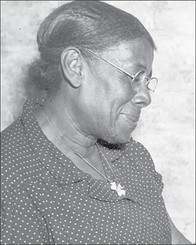Virginia Estelle Randolph
Introduction
Text-to-speech Audio
Virginia Estelle Randolph's innovative teaching techniques at her school on Mountain Road became the model for African American education throughout the South early in the twentieth century. Henrico County currently operates the Academy at Virginia Randolph for academically challenged students and a museum at the Virginia Randolph Cottage.
Images
Photograph of Virginia Estelle Randolph, courtesy of the Richmond Times-Dispatch.

The Library of Virginia honored Virginia Estelle Randolph as one of its Virginia Women in History in 2009.

The Virginia Women in History Digital Trail is made possible by the Library of Virginia and American Evolution: Virginia to America, 1619–2019.

Backstory and Context
Text-to-speech Audio
The child of former slaves, Virginia Estelle Randolph (June 8, 1874–March 16, 1958) completed her education at the age of sixteen and took her first teaching job in Goochland County. In 1892 she began teaching at the Mountain Road School, in Henrico County. There she developed her unique approach to education by creating a successful formula based on practicality, creativity, and involvement from parents and the community. A firm believer in learning through doing, Randolph combined academic instruction with lessons on cooking, weaving, and gardening. Because of her innovative teaching style, in October 1908 she became the first Jeanes Supervisor Industrial Teacher, a position she held for more than forty years. Her work took her throughout the South and earned her a national and international reputation as a leader in education.
In 1915 a new high school for African Americans, the Virginia Randolph County Training School, was constructed in Randolph's honor. In 1930 a larger brick building replaced the original school after a fire destroyed it. In 1924 a girls' dormitory opened, located on three acres purchased by Randolph next to the school, to provide housing for thirty female students. Randolph also took students into her own home. The 1930 census lists fourteen "adopted" sons and daughters, ranging in age from eleven to nineteen, living in her household.
In 1915 a new high school for African Americans, the Virginia Randolph County Training School, was constructed in Randolph's honor. In 1930 a larger brick building replaced the original school after a fire destroyed it. In 1924 a girls' dormitory opened, located on three acres purchased by Randolph next to the school, to provide housing for thirty female students. Randolph also took students into her own home. The 1930 census lists fourteen "adopted" sons and daughters, ranging in age from eleven to nineteen, living in her household.
In recognition of her success, Randolph received a William E. Harmon Award in 1926. She retired in 1949 and died in 1958. In 1970 the Virginia Randolph School was dedicated as a museum, and in 1974 the Virginia Randolph Cottage became a National Historic Landmark.
Reprinted with permission of the Library of Virginia.
Reprinted with permission of the Library of Virginia.
